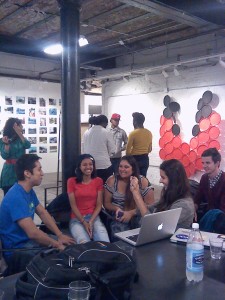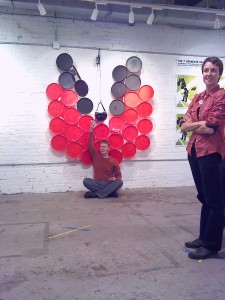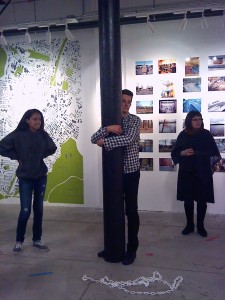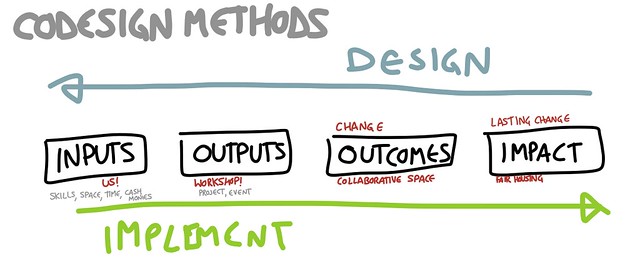The Codesign Studio concluded on Tues May 14. This year we had 8 enrolled students, a mix of graduate and undergraduate students from around the institute, from Computer Science, Department of Urban Studies and Planning, Mechanical Engineering and from other universities — Boston University, Harvard’s Kennedy School, and Wellesley. Our partners were Cambridge Community Television (CCTV) and Design Studio for Social Intervention (DS4SI).

This is the second time I’ve TA’d this class. The following are some observations from the courses in 2012 and 2013 and how these are helping us to reflect and iterate on the structure of the course and how these iterations played out in the most recent term. In Spring 2012, Sasha Costanza Chock was instructor. You can see the 2012 syllabus here: http://brownbag.me:9001/p/codesignstudio. In that class, students worked individually and in small groups with community partners to collaboratively design media and communication projects and the syllabus was a mix of theoretical grounding at the intersection of collaborative design and social justice and hands-on codesign: http://codesign.mit.edu/projects/. Most class meetings were split between discussion of readings to provide theoretical and historical context and hands-on activities facilitated by project groups. In Spring 2013, with Federico Casalegno as the lead instructor and Denise Cheng and myself as TAs, the class worked in 2 groups. In early classes, the class developed an understanding of codesign through investigating existing work and becoming familiar with their partners’ work. This semester, our partners joined us during class meetings and for most of the semester, class meetings began with group updates and were followed by separate group work. You can see the syllabus here: http://bit.ly/codesignstudio2013.
Some of the changes to the structure of the course were made in response to observations about the 2012 course. The goal in making these changes was to create container in which students and partners were able to practice design together and to focus on the projects more than the project development.

Observation: Building partnerships and to specifying projects takes time
Adjustment: Create project partnerships and identify problems in advance of the beginning of the term
In 2012 students were responsible for forming a partnership with a community partner and identifying a problem or project to work on together. These steps took more time for some groups which meant less time for experimenting and implementing. In order to remove these initial steps so that groups could begin the course instead with developing their working relationships and designing and iterating, we initiated the partnerships and identified problems together before the start of the class.
In December and January, I spoke with a number of potential partners for the course. At the start of the term, we had 3 partners prepared to join the class and I had spoken to an additional two. One of our partners, a student organizing group, was unable to join as we began the term because the people who would have joined our class had classes of their own at the same time.
Of the potential partners I spoke with with whom we did not partner for the class, joining the meeting time weekly was a limitation. Some of these groups are volunteer committees and both making the time to join the class and agreeing on a problem of high priority to address through the class were challenges.
Even with partnerships and problem definitions in place, groups evolve as the term continues developing intragroup working relationships and clarifying project aims as they iterate.
Observation: Class time was separate from group working time, creating separation between conceptual learning and practice
Adjustment: To create one shared space for the processes of learning and practicing codesign, we invited partners to join the class during class time
Feedback at the end of the term from partners was that this format allowed for weekly meeting times that were productive, but that the time commitment was challenging some weeks. It also meant that the groups had enough time to communicate and work together.
Each group included 2 individuals from the partner organizations and as the term continued, the individuals alternated attending class so there was one member present for each class meeting. This seemed to work fine and split the time between 2 people.
Holding the class meetings as a space for both enrolled students and partners did create formal space for inclusion of additional voices in decision making. After the midterm, both groups met with more members of their partner groups. From the midterm discussion, it was clear to the CCTV group that the journalists were a key part of increasing the visibility of the NeighborMedia program. The CCTV group met with NeighborMedia journalists continuously for the remainder of the course. The DS4SI group included the 2 directors of DS4SI in the class immediately following the midterm review and had a clarifying discussion, confirming some design choices and laying out open needs and questions.
One element lost from engaging during class meeting times with project teams was that teams were not explicitly required to meet together in one another’s spaces. In future courses, we should suggest or require that groups work early and throughout the course in the partners’ spaces some weeks and in the campus meeting space other weeks. This will help the group to ground their suggestions and plans in understanding of the partner’s operating environment.
Observation: Concluding projects is difficult
Adjustment: We identified problems and projects with a clear end date, designed for a specific event
In the 2012 class and in our work at the Center more broadly, defining an end-point for an engagement can be difficult. If the work we are doing requires maintenance over time or ongoing administration and management — who will do that work? If the work we are doing together is iterating on existing services and campaigns, how do you decide when the final iteration is? To help ease defining the how the engagements for the 2013 class would end, projects, we defined this with our partners before the class began.
Reflecting on the popularity of hackathons, day to weeklong design and development sessions, we thought about designing the course as a critique of hackathons with a focus on collaboratiavely creating an inclusive design event. In the end, our projects were developed for a specific event, but were not framed as hackathons.
We addressed this when we developed problem statements with our partners. With CCTV, our problem was how to increase the visibility of the NeighborMedia program in time for the 5 year Anniversary event; with DS4SI, our problem was how to make planning processes public as a component of the Making Planning Processes Public event.
New observations from this term
Our midterm review period was a moment that catalyzed collaboration in new ways because it required the groups to share proposed designs and to reflect on how their designs and aligned with the needs and interests of the partners. As a result, both groups met the following week with additional people from their partner organizations to have conversations that generated ideas more consistent with their partners’ needs and vision. I think we can actively create this kind of catalytic moment earlier in the semester by doing early sketch reviews or perhaps just by making this review earlier in the term.
Both teams were very multidisciplinary and the resulting work was an expression of their myriad skills and talents. This class has drawn students from MIT and elsewhere who are developing skills in wide ranging fields. This has led to rich projects in both semesters and is something we should continue to welcome.
Enroll in the Fall 2013 Codesign Course!
We’ll hold this class again in the Fall 2013 semester listed as CMS.362/.862, Tues 7-10pm E15-363. Sasha Costanza Chock will again be the Instructor for the course and I’ll TA. We’ll be working on the design of the course this summer. Please consider signing up or getting in touch if you’re interested!














